The RSSY ETF aims to provide a “return stacked” solution for U.S. stocks and futures yield in a single fund. It's called the Return Stacked® U.S. Stocks & Futures Yield ETF. I review it here.
Disclosure: Some of the links on this page are referral links. At no additional cost to you, if you choose to make a purchase or sign up for a service after clicking through those links, I may receive a small commission. This allows me to continue producing high-quality content on this site and pays for the occasional cup of coffee. I have first-hand experience with every product or service I recommend, and I recommend them because I genuinely believe they are useful, not because of the commission I may get. Read more here.
If you've landed here, it's highly likely that you're already at least somewhat familiar with “return stacking” and you've probably even already checked out the other funds in this family like RSSB and RSST, but in the interest of full disclosure in case you've never heard of any of that, I'll take a second to do a very brief refresher on what “return stacking” is.
Essentially, it refers to layering different return streams on top of one another via leverage (borrowing). I explained this idea in detail in a separate post here. I'd highly recommend reading that post first and then coming back here. The creators of the RSSY ETF actually trademarked the term Return Stacked®.
So as I just mentioned, RSSY is part of a broader family of ETFs from Return Stacked® that also includes RSSB, RSST, and RSBT. I've got separate posts on all those. RSSY is the newest, having launched in May 2024. All these funds utilize leverage to “stack” different combinations of assets like stocks, bonds, and managed futures.
Using a phrase from the fund provider themselves, this borrowing (i.e. leverage) allows investors to “achieve more than $1.00 of exposure for each $1.00 invested.” The primary goal in doing so is not to just lever up beta but rather to maintain core exposure while freeing up space to add in additional sources of expected return. In that sense, we're effectively able to deploy additional capital that we wouldn't otherwise have.
“Return stacking” specifically refers to this extra step of utilizing additional diversifiers. If these diversifiers are uncorrelated to whatever we're already using for the core portfolio, doing so can actually reduce risk in some cases. This idea may be particularly useful in the face of low expected returns for multiple core assets like stock and bonds.
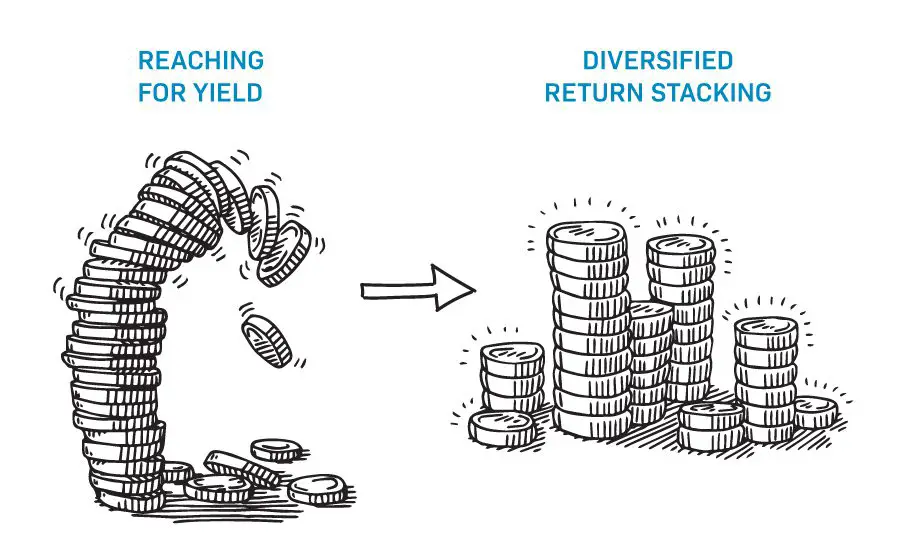
I discussed this idea previously in my blog post on the NTSX ETF from WisdomTree years ago, which “stacks” US stocks and US Treasury bonds, albeit at a lower leverage ratio than the Return Stacked® family of ETFs.
Here with RSSY, as the name suggests, we're effectively stacking U.S. stocks and futures yield at 100% each. In other words, for every $1 invested, this ETF seeks to provide $1 of exposure to U.S. stocks and $1 of exposure to its futures yield strategy.
First let's talk about the stocks piece, which is the second “S” in RSSY. It's aiming for U.S. large caps represented by the famous S&P 500 Index, which is composed of the 500 largest profitable companies in the United States. RSSY achieves that exposure via a straight S&P 500 index fund (specifically IVV from iShares) and S&P 500 index futures. For example, RSST may hold 50% in a large-cap U.S. equity ETF and gain the remaining 50% equity exposure through U.S. equity index futures.
- 50% iShares S&P 500 ETF (“IVV”)
- 50% S&P 500 E-Mini Futures Contract
For all intents and purposes, with some hand waving and an admittedly reductive summary, think of this piece as effectively 100% in the S&P 500.
What you're almost certainly much more curious about is the second half of the fund which is the futures yield strategy (the “Y” in the ticker), which aims to harvest “roll yield,” also referred to colloquially as “carry.” As the name suggests, this strategy aims to capture the economic benefit of simply holding or “carrying” an asset. The minimum cost of carrying an asset is the return on cash, which we're foregoing by buying the asset instead. RSSY aims to capture this roll yield by utilizing a systematic and quantitative long/short trading strategy across commodities, currencies, bonds, and equities via futures contracts.
So what's the reason for such carry premia to exist in the first place? You can think of them as essentially compensation for taking on the risks of holding such assets, providing risk-based explanations across all four asset types that the fund holds, including but not limited to:
- illiquidity risk
- inflation risk
- monetary policy risk
- etc.
For a couple tangible examples you're likely familiar with, this shows up as dividends from stocks and coupon payments from bonds.
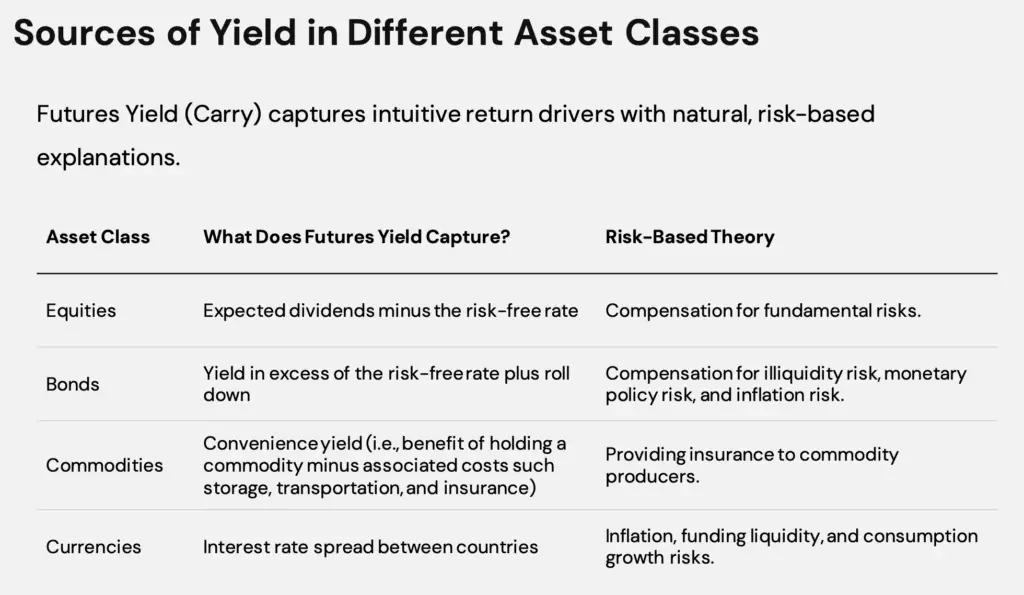
Portfolio weights and directions of this futures yield sleeve are determined by calculating and optimizing for aggregate risk-adjusted carry premium across all assets in its selection universe, with an overall target annualized volatility of 10%. That investable universe spans 26 different futures markets across the globe:
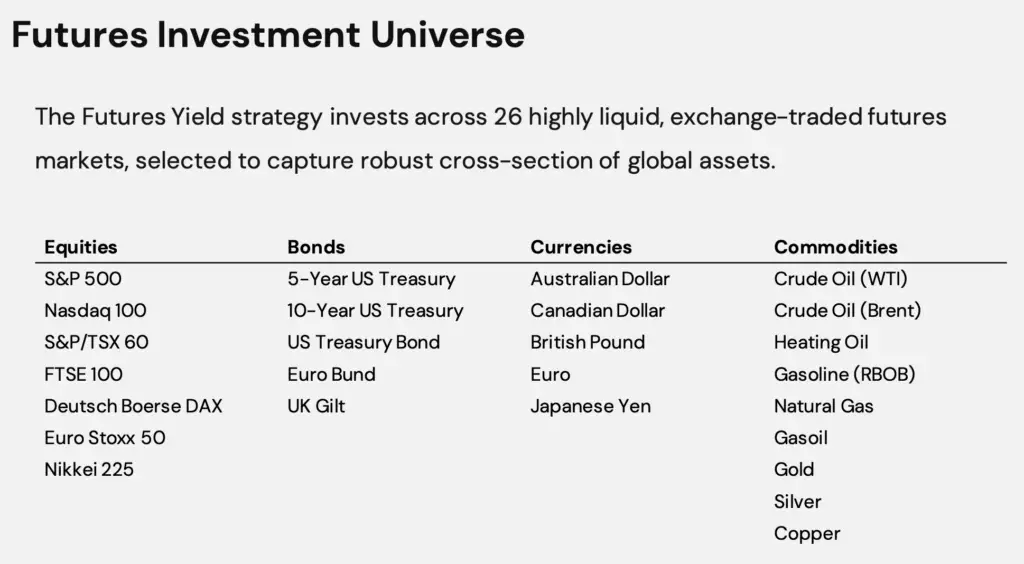
The details of the construction of such a strategy and the purported optimality thereof are beyond the scope of this blog post, but ReSolve have a nice whitepaper on the topic that you can find here if you're an investment professional.
Notice how such a long/short trading strategy results in dynamic weights that can shift over time:
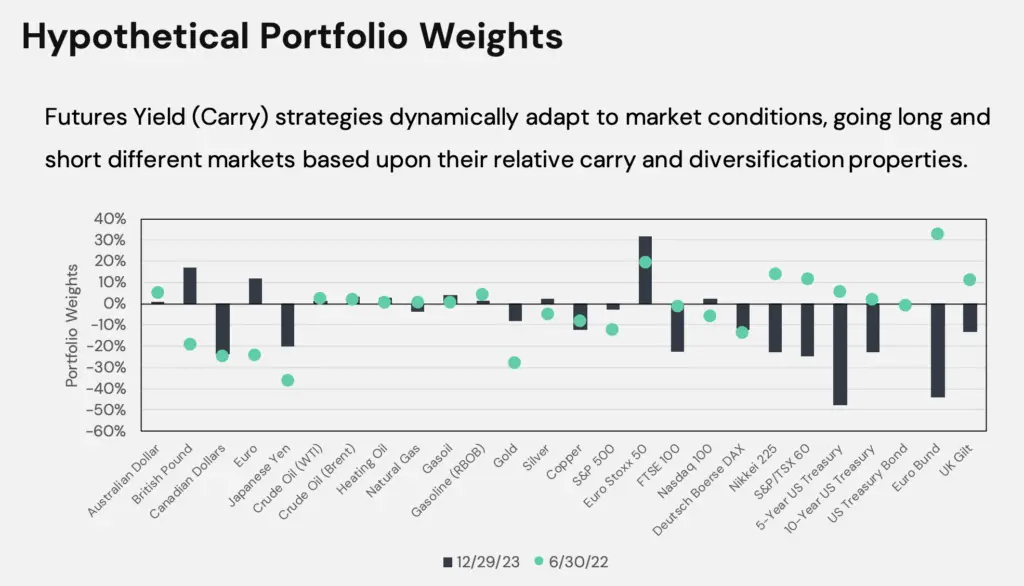
Carry may prove to be a useful diversifier with positive expected returns and structural uncorrelation to both stocks and bonds:
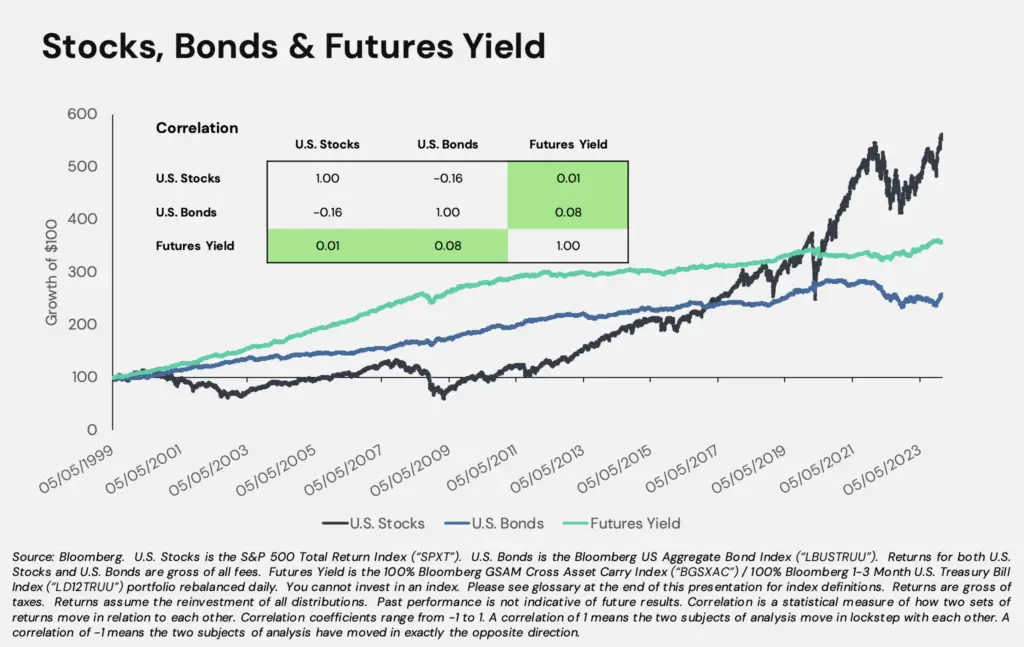
Carry has also historically been uncorrelated to Trend as well, which we covered in the posts on RSST and RSBT, suggesting it may be useful to combine some of these funds for additional return streams. Modern Portfolio Theory reminds us that all else equal, assuming positive expected returns, we usually want to try to maximize the number of uncorrelated assets in the portfolio to reduce volatility and risk and increase return per unit of risk, which we call risk-adjusted return.
Some investors may prefer the more intuitive risk-based explanations for Carry over the more behavior-based explanation for Trend, which may largely just be the result of biases like status quo bias, loss aversion, and herding. It's also perhaps worth noting that historically, Carry has been positively correlated with a core stocks/bonds portfolio during “normal” economic times and negatively correlated during periods of market turmoil, which is sort of the holy grail of diversifiers.
Just as with RSST which holds stocks and managed futures, RSSY could be one's entire single-ETF portfolio if you wanted the exposure it delivers. Or you could obviously continue “stacking” additional diversifiers like plain vanilla bonds, Trend, etc. Here's a hypothetical example to illustrate the latter:
We could easily naively weight stocks, bonds, Trend, and Carry at 50% each for total notional exposure of 200% using 50% RSSY and 50% RSBT, the Return Stacked® Bonds & Managed Futures ETF. While this portfolio appears pretty simple with only 2 ETFs, it is potentially extremely powerful with 4 uncorrelated assets. Return Stacked® co-creator Rodrigo Gordillo, CIM, President & Portfolio Manager at ReSolve Asset Management, informally referred to this “all terrain” allocation as the “Return Stacked Quad Core Portfolio.” You can invest in it here. And while the historical performance of such a portfolio is entirely hypothetical and simulated, it's pretty incredible:

Here are the summary metrics. Check out that high Sharpe ratio that we do get to eat in this case:

Notice how this portfolio would have really shined in rough years like 2000, 2008, and 2022:

Zooming out away from the minutiae of futures contracts and Carry and Trend, we're basically taking on multiple sources of systematic risk that tend to be uncorrelated to each other, which of course is the entire goal of diversification at the end of the day. In that sense, you could think of this as a more sophisticated implementation of an “all weather” approach where we usually only see a long-only basket of a handful of straightforward assets like stocks, bonds, and commodities with investors who may be constrained to leverage and shorting. And make no mistake, that long-only basket we usually talk about is still potentially a great idea, but these additional strategies like Carry and Trend would even be uncorrelated to all the assets in that basket.
Such is the beauty of these Return Stacked® solutions – simple, packaged products that offer robust exposure that was previously much harder, if not impossible, for the retail investor to achieve. Institutions have been using these ideas for decades, but most in the retail space wouldn't have the knowledge to even begin to borrow capital and use it to implement a roll yield strategy, for example, much less the desire for that ongoing management.
Here's this idea of “stacking” building blocks with respect to RSSY visualized using 60/40:
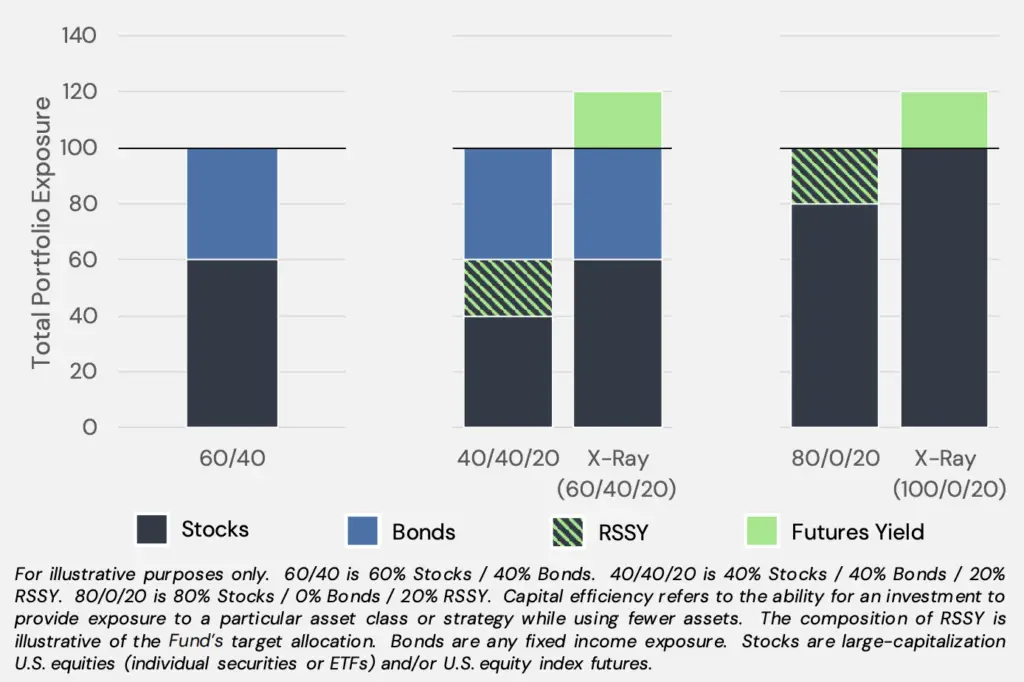
Fun fact: RSSY is brought to you by some of the same names who initially discussed the ideas surrounding capital-efficient “return stacking” that ultimately led to the creation of funds like NTSX and RPAR.
- Tidal Investments LLC serves as the investment adviser.
- Corey Hoffstein and the gang at Newfound Research LLC serve as the sub-adviser.
- Rodrigo Gordillo, Adam Butler, Michael Philbrick, and the folks at ReSolve Asset Management SEZC serve as the futures trading advisor.
- Foreside Fund Services, LLC is the distributor.
Because of the trading and daily rebalancing, note that RSSY has much higher turnover and would be considered much less tax-efficient than something like your typical plain vanilla equities index fund, so it may be most suitable for tax-advantaged space like an IRA.
RSSY's fee of 1.04% is pretty par for the course in this arena of futures trading and leverage. Remember you're getting 100% stocks plus 100% Carry strategy, and fees are relative to the exposure you're paying for.
Further, while the word “leverage” may make you automatically think of a young kid with a long horizon and high risk tolerance, recognize that these Return Stacked® products are certainly not solely for that accumulator audience and could just as easily be utilized by the retiree on the other extreme who simply wants to enhance portfolio diversification without additional capital outlay.
At the end of the day, I'm always a fan of products that bring strategies to the hands of retail investors that were previously only accessible by institutions and sophisticated traders.
Lastly, remember that while I think it's being used pretty thoughtfully and modestly here in the instances I've referenced, leverage is not a free lunch and can result in larger losses than an unlevered portfolio when multiple asset classes converge and move down at the same time, and high financing costs can add insult to that injury. Derivatives are also not guaranteed to perfectly track their target exposure.
As with any product, investors should obviously fully understand these risks and read RSSY's prospectus before buying it.
RSSY has attracted about $125M in assets since it launched in mid 2024. The fund rebalances daily and makes distributions annually.
RSSY should be available at any major broker, including M1 Finance, which is the one I'm usually suggesting around here.
What do you think of RSSY? Let me know in the comments.
Disclosure: I am long NTSX.
Disclaimer: While I love diving into investing-related data and playing around with backtests, this is not financial advice, investing advice, or tax advice. The information on this website is for informational, educational, and entertainment purposes only. Investment products discussed (ETFs, mutual funds, etc.) are for illustrative purposes only. It is not a research report. It is not a recommendation to buy, sell, or otherwise transact in any of the products mentioned. I always attempt to ensure the accuracy of information presented but that accuracy cannot be guaranteed. Do your own due diligence. I mention M1 Finance a lot around here. M1 does not provide investment advice, and this is not an offer or solicitation of an offer, or advice to buy or sell any security, and you are encouraged to consult your personal investment, legal, and tax advisors. Hypothetical examples used, such as historical backtests, do not reflect any specific investments, are for illustrative purposes only, and should not be considered an offer to buy or sell any products. All investing involves risk, including the risk of losing the money you invest. Past performance does not guarantee future results. Opinions are my own and do not represent those of other parties mentioned. Read my lengthier disclaimer here.

Are you nearing or in retirement? Use my link here to get a free holistic financial plan and to take advantage of 25% exclusive savings on financial planning and wealth management services from fiduciary advisors at Retirable to manage your savings, spend smarter, and navigate key decisions.

50% RSSB; 25% RSST; 25% RSSY seems like a pretty solid portfolio to hold, forever. 100% stocks (with US bias unfortunately); 25% Managed Futures; 25% Carry. Should outperform 100% equities, certainly should outperform a 60/40. I just wish RSST and RSSY were global equities like RSSB is, but (alas) beggar’s cannot be choosers with these products.
I like the idea of it, but ultimately I don’t think it’s compelling enough to justify the higher price relative to just sticking with 100% RSSB from the good folks over there. Heck, I think that fund has now pretty conclusively replaced most of PSLDX’s appeal unless you really hate international stocks or want actively managed long bonds.